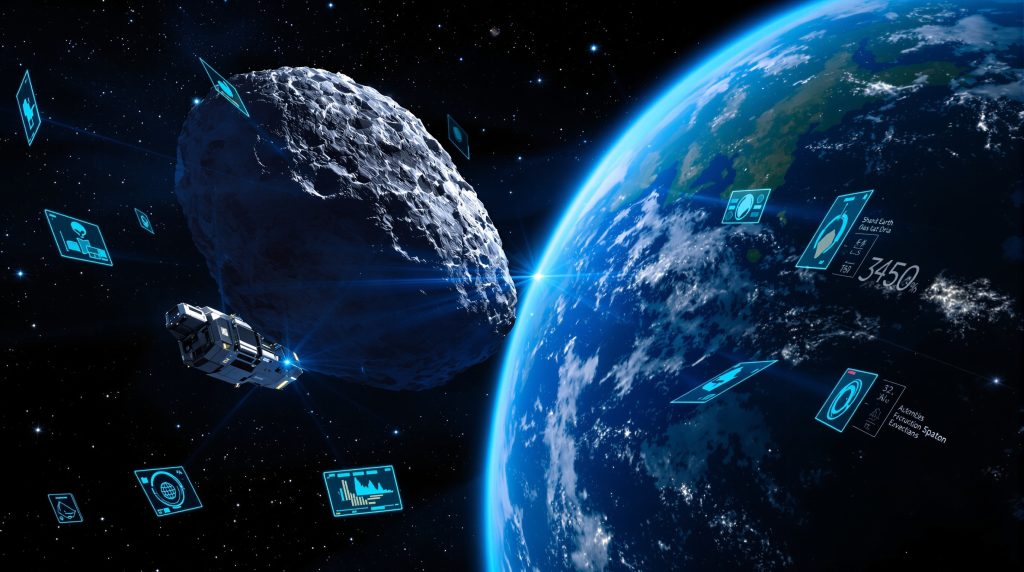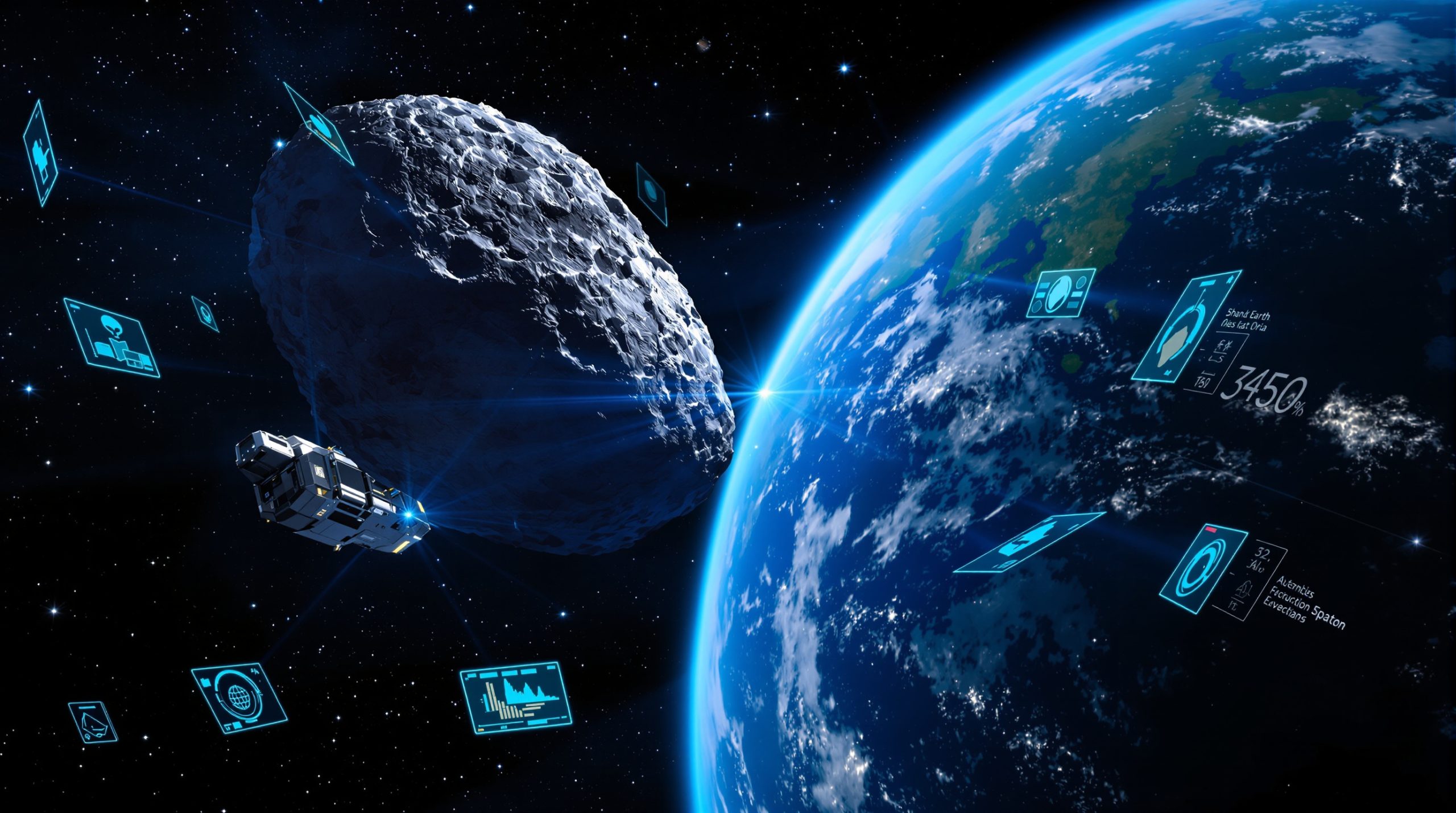Fleet Space's Apophis Mission: Revolutionizing Asteroid Exploration in 2029
In a groundbreaking initiative set to transform our understanding of near-Earth objects, Fleet Space Technologies is preparing to study the asteroid Apophis during its rare close approach to Earth in 2029. This ambitious mission represents a pivotal moment in space exploration, combining cutting-edge geophysical sensing technology with the urgent needs of planetary defense and resource identification.
Understanding the ApophisExL Mission
ApophisExL, the collaborative venture between Fleet Space and ExLabs, will deploy sophisticated geophysical sensing technologies aboard ExLabs' mothership spacecraft. This mission aims to collect crucial data about Apophis's internal structure, composition, and resource potential during its close flyby on April 13, 2029.
The spacecraft will launch in 2028, giving scientists a once-in-7,500-years opportunity to study this significant asteroid up close. Primary mission objectives include detailed characterization of Apophis's geological composition, assessment of valuable resources within the asteroid, advancement of planetary defense capabilities, and field testing of technologies designed for off-world exploration.
Fleet Space's contribution focuses on adapting their Earth-proven geophysical sensing systems for space applications. These technologies will enable real-time subsurface imaging of the asteroid, providing comprehensive data that will inform future exploration of not just asteroids, but the Moon and Mars as well.
The Significance of Apophis as an Exploration Target
A Rare Scientific Opportunity
Apophis presents an exceptional research opportunity due to its unprecedented proximity during the 2029 flyby. At just 32,000 kilometers from Earth's surface—closer than our geosynchronous satellites—this 340-meter diameter asteroid will be visible to the naked eye in some parts of the world.
The rarity of this event cannot be overstated. Such close approaches by asteroids of this size occur approximately once every 7,500 years, making this a truly generational opportunity for scientific advancement.
From Potential Threat to Scientific Treasure
When astronomers first discovered Apophis in 2004, it caused considerable concern. Initial calculations gave the asteroid a 2.7% probability of Earth impact—the highest rating on the Torino scale used to categorize potential asteroid threats. This alarming statistic made Apophis briefly infamous as one of the most dangerous near-Earth objects ever discovered.
Subsequent observations and refined trajectory calculations have completely eliminated this impact risk. However, the close approach still offers invaluable opportunities to:
- Study how Earth's gravity influences asteroid trajectories
- Test global planetary defense monitoring systems in real-time
- Develop international protocols for future near-Earth object encounters
- Gain unprecedented insights into asteroid composition and structure
Key Characteristics of Apophis
| Feature | Measurement |
|---|---|
| Average diameter | 340 meters |
| Earth flyby distance | ~32,000 kilometers |
| Discovery date | 2004 |
| Close approach frequency | Once per 7,500 years |
| Initial impact probability (2004) | 2.7% |
| Current impact probability | 0% |
Fleet Space's Revolutionary Exploration Technology
ExoSphere: From Mining Industry to Space Exploration
At the heart of Fleet Space's asteroid exploration capabilities is their ExoSphere technology—a system already revolutionizing Earth-based mining operations. Major mining companies currently use ExoSphere for real-time orebody imaging, allowing them to identify mineral deposits with minimal environmental impact.
For the Apophis mission, this technology is being adapted for the unique challenges of space applications. The space-rated version of ExoSphere will enable:
- Non-invasive imaging of Apophis's internal structure
- Rapid characterization of geological composition
- Identification of potential resources within the asteroid
- Data collection that informs exploration decisions
As Fleet Space's Chief Science Officer Gerrit Olivier explains: "We need precise geophysical and mineralogical data to characterize composition, structure, and behavior in order to determine how materials can be accessed and utilized. By advancing off-world sensing capabilities, we're creating the scientific foundation for proactive planetary defense and sustainable expansion into the solar system."
SPIDER: Lunar Testing Ground
Before tackling Apophis, Fleet Space is validating their technologies through the SPIDER lunar exploration system. Scheduled for deployment on Firefly Aerospace's Blue Ghost Mission 2, SPIDER will test critical capabilities on the lunar surface, including:
- Advanced seismic sensing in low-gravity environments
- Subsurface geological mapping techniques
- Autonomous data collection and transmission protocols
- Operations in extreme temperature and radiation conditions
This lunar mission serves as a crucial stepping stone, allowing Fleet Space to refine their technologies before applying them to asteroid exploration.
Technology Development Pathway
Fleet Space's approach follows a logical progression:
- Initial deployment of ExoSphere with Earth-based mining partners
- Lunar validation through the SPIDER mission
- Application of refined technologies to the Apophis mission
- Future expansion to Mars and other destinations
This systematic approach ensures that each mission builds upon previous successes, creating a robust foundation for increasingly ambitious exploration.
Asteroids: Trillion-Dollar Resources in Space
The Extraordinary Mineral Potential
Recent scientific research has revealed that certain near-Earth asteroids contain truly staggering mineral wealth. Some metal-rich asteroids may contain more iron, nickel, and cobalt than Earth's entire known reserves.
The Planetary Science Journal published findings on asteroids 1986 DA and 2016 ED85, estimating them to be approximately 85% metal by composition. When calculated at current market prices, a single moderate-sized metallic asteroid could contain trillions of dollars worth of industrial and precious metals.
This extraordinary resource potential has implications across multiple sectors:
- Space manufacturing: Providing raw materials for in-space construction
- Energy transition: Supplying critical minerals needed for renewable technologies
- Earth-based industries: Potentially transforming supply chains for scarce resources
- Economic paradigms: Creating new models for resource availability and utilization
The Challenges of Asteroid Resource Utilization
Despite their incredible potential value, numerous challenges remain before asteroid resources can be practically utilized:
- Engineering difficulties in low-gravity mining operations
- Logistical complexities of resource transportation
- Unresolved legal frameworks regarding space resource rights
- Economic viability concerns for extraction and processing
- Technical requirements for in-situ resource utilization
The Apophis mission represents a crucial step in addressing these challenges by providing detailed data on asteroid composition and structure—information essential for developing practical resource utilization approaches. Furthermore, ongoing asteroid mining advances highlight the industry's growing importance in the space economy.
Advancing Planetary Defense Through the Apophis Mission
Building Critical Knowledge for Earth Protection
Beyond resource identification, the Apophis mission serves another vital purpose: enhancing our planetary defense capabilities. The data collected will provide invaluable insights for protecting Earth from potential asteroid threats by:
- Characterizing asteroid internal structures and composition variations
- Understanding how Earth's gravity affects asteroid trajectories during close approaches
- Testing detection and monitoring systems with a known target
- Developing protocols and technologies for future potential hazards
From Theory to Practical Applications
The knowledge gained from studying Apophis will have direct applications for Earth's safety:
- More accurate predictive modeling of asteroid trajectories
- Better understanding of deflection requirements based on composition data
- Enhanced monitoring capabilities for near-Earth objects
- Development of international cooperation frameworks for planetary defense
Earth's Impact History: A Reminder of Risk
The mission draws important parallels to Earth's own impact history, such as the Haughton Impact Crater on Devon Island in the Canadian Arctic. Created approximately 23 million years ago by an asteroid or comet collision, this 20-kilometer diameter, 1.7-kilometer deep crater serves as a sobering reminder of the potential consequences of asteroid impacts.
Scientists use sites like Haughton as analog environments for testing space technologies and understanding impact signatures. The knowledge gained from studying both Earth's impact sites and close-approaching asteroids like Apophis creates a comprehensive framework for planetary defense. Additionally, advanced 3D geological modelling techniques are now being applied to better understand these celestial bodies.
The Broader Vision: Beyond Apophis
Creating a Sustainable Space Economy
The Fleet Space Apophis mission represents just one component of Fleet Space's broader vision for off-world exploration and resource utilization. This vision encompasses:
- Establishing standardized protocols for asteroid resource assessment
- Creating frameworks for space data sharing and commercialization
- Developing prioritization methods for future asteroid targets
- Building technical capabilities for sustainable off-world operations
Global Collaboration Framework
To achieve these ambitious goals, Fleet Space is advancing off-world exploration science alongside leading global institutions:
- Stanford University's Mineral-X initiative
- MIT Space Exploration Initiative
- NASA and other international space agencies
- Research institutions focused on space resource utilization
This collaborative approach ensures the integration of diverse expertise and resources, maximizing the scientific and practical outcomes of the mission. Recent mineral exploration insights from Earth-based projects are also being incorporated into space resource assessment methodologies.
Investing in Future Capabilities
Fleet Space's commitment to this vision is demonstrated by recent significant developments:
- Securing US$150 million in Series D funding
- Establishing an advanced manufacturing facility capable of producing thousands of geophysical sensors and hundreds of satellites annually
- Scaling production systems to support an expanded era of space exploration
- Developing technologies that bridge terrestrial mining experience with space applications
Long-Term Implications of the Apophis Mission
Scientific Advancement
The scientific knowledge gained from the Apophis mission will extend far beyond the asteroid itself:
- Enhancing our understanding of asteroid formation and solar system evolution
- Providing new insights into the behavior of near-Earth objects
- Improving modeling capabilities for celestial bodies
- Testing novel exploration technologies applicable to multiple targets
Economic Transformation
The mission may also catalyze economic transformations:
- Creating frameworks for asteroid resource valuation
- Developing potential new supply chains for critical minerals
- Opening commercial opportunities in space resource utilization
- Establishing investment pathways for space mining ventures
As the space industry evolves, mining innovation trends from terrestrial operations are increasingly being adapted for off-world applications, creating new economic opportunities.
Expanding Human Presence Beyond Earth
Perhaps most significantly, the Apophis mission represents a foundational step in humanity's expansion beyond Earth:
- Testing technologies essential for sustainable off-world presence
- Identifying resources needed for future lunar and Martian settlements
- Building the knowledge foundation for interplanetary infrastructure
- Advancing humanity's capability to operate throughout the solar system
Understanding mineralogy and mining economics will be crucial as we expand our resource utilization beyond Earth, with Fleet Space leading significant advancements in this field.
Frequently Asked Questions
When exactly will Apophis pass by Earth?
Apophis will make its closest approach to Earth on April 13, 2029, passing at a distance of approximately 32,000 kilometers from Earth's surface—closer than our geosynchronous satellites.
Is Apophis still considered a threat to Earth?
No. While initial observations in 2004 gave Apophis a 2.7% chance of Earth impact, subsequent tracking has completely eliminated this risk. The asteroid now represents a scientific opportunity rather than a threat.
What makes this mission different from other asteroid missions?
The Fleet Space Apophis mission is unique in its focus on geophysical sensing technologies specifically designed to characterize the asteroid's subsurface composition and structure, building on technologies proven in Earth-based mining applications.
How will data from this mission be used?
Data collected will advance planetary defense strategies, identify potential resources, create frameworks for future asteroid prospecting, and develop technologies applicable to lunar and Martian exploration.
What happens after the Apophis mission?
Knowledge gained from the Apophis mission will inform future asteroid exploration, potential resource utilization efforts, and the development of technologies needed for sustainable human presence on the Moon, Mars, and beyond.
Disclaimer: This article contains forward-looking statements about space exploration technologies, resource utilization, and mission outcomes. Actual results may differ from projections due to technological, regulatory, or scientific developments.
Ready to Track the Next Major Mineral Discovery?
Discover real-time ASX mineral discovery alerts powered by Discovery Alert's proprietary Discovery IQ model, which instantly transforms complex mining data into actionable investment opportunities. Explore historic examples of exceptional returns from major discoveries on the Discovery Alert discoveries page and position yourself ahead of the market.




